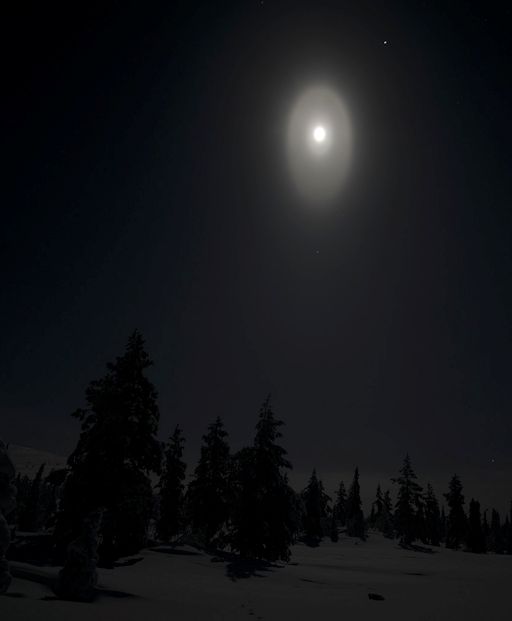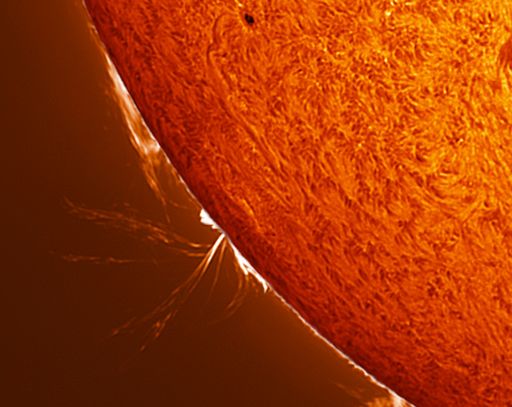When is the best time to see auroras? Where is the best place to go? And how do you photograph them? These questions and more are answered in a new book, Northern Lights - a Guide, by Pal Brekke & Fredrik Broms. | | | CHANCE OF STORMS: A minor CME expected to hit Earth's magnetic field on Jan. 17th is late, but NOAA forecasters still think it is coming. They estimate a 40% chance of polar geomagnetic storms on Jan. 18th in response to the tardy impact. High-latitude sky watchers should be alert for auroras. Aurora alerts: text, voice. MYSTERIOUS MOON HALOS OVER FINLAND: Luminous halos around the Moon are nothing unusual, especially in wintertime Finland where the air is so often filled with ice. Crystals of frozen H2O catch the moonlight and bend it into a circular ring of light. A few nights ago, however, Sauli Koski of Muonio, Finland, witnessed a halo that was not circular, but elliptical: 
"On Jan. 15th, the weather changed. As the temperature dropped from -7C to -37C, there were all kinds of ice halos to photograph," says Koski. "The best and rarest were these elliptical forms that lasted more than 20 minutes." Although physicists have been studying ice halos for decades, not all are understood. "Elliptical halos are one of the puzzles," says atmospheric optics expert Les Cowley. " We can simulate them by invoking hexagonal plate-like crystals topped by almost flat pyramid faces. However, the simulations do not fit very well and such crystals are unphysical. Crystal facets like to form along planes where there are lots of atoms or molecules – almost flat pyramids do not fit the bill at all. Perhaps some peculiar distorted snowflake types instead?" "These mysteries all add to the spice of halo observing, the beautiful, the unexpected, the unexplained, something new!"
Realtime Space Weather Photo Gallery SUNSPOT AROUND THE CORNER: A sunspot approaching from just behind the sun's southeastern limb is crackling with solar flares. The explosions are registering C2 to C8 on the Richter Scale of Flares even though they are partially eclipsed by the edge of the sun. In Athens, Greece, amateur astronomer Peter Desypris photographed the flying debris from one of the explosions: 
"Indeed, something big appears to be on the way," says Desypris. The sun's rotation is slowly turning the active region toward Earth. During the weekend its core should emerge into plain view for a better evaluation of its flare-producing potential. Stay tuned for updates. Solar flare alerts: text, voice. Realtime Space Weather Photo Gallery
Realtime Venus Photo Gallery
Realtime Comet Photo Gallery
Every night, a network of NASA all-sky cameras scans the skies above the United States for meteoritic fireballs. Automated software maintained by NASA's Meteoroid Environment Office calculates their orbits, velocity, penetration depth in Earth's atmosphere and many other characteristics. Daily results are presented here on Spaceweather.com. On Jan. 18, 2014, the network reported 15 fireballs.
(15 sporadics) 
In this diagram of the inner solar system, all of the fireball orbits intersect at a single point--Earth. The orbits are color-coded by velocity, from slow (red) to fast (blue). [Larger image] [movies] On Jan. 17, 2014, the network reported 8 fireballs.
(8 sporadics) 
In this diagram of the inner solar system, all of the fireball orbits intersect at a single point--Earth. The orbits are color-coded by velocity, from slow (red) to fast (blue). [Larger image] [movies] Potentially Hazardous Asteroids ( PHAs) are space rocks larger than approximately 100m that can come closer to Earth than 0.05 AU. None of the known PHAs is on a collision course with our planet, although astronomers are finding new ones all the time. On January 18, 2014 there were 1451 potentially hazardous asteroids. Notes: LD means "Lunar Distance." 1 LD = 384,401 km, the distance between Earth and the Moon. 1 LD also equals 0.00256 AU. MAG is the visual magnitude of the asteroid on the date of closest approach. | | The official U.S. government space weather bureau | | | The first place to look for information about sundogs, pillars, rainbows and related phenomena. | | | Researchers call it a "Hubble for the sun." SDO is the most advanced solar observatory ever. | | | 3D views of the sun from NASA's Solar and Terrestrial Relations Observatory | | | Realtime and archival images of the Sun from SOHO. | | | from the NOAA Space Environment Center | | | the underlying science of space weather | | 
